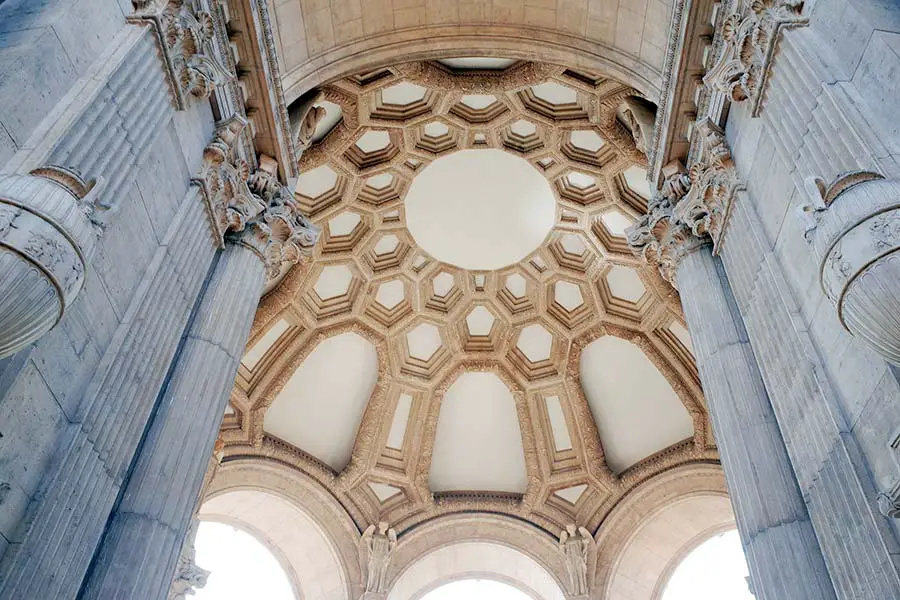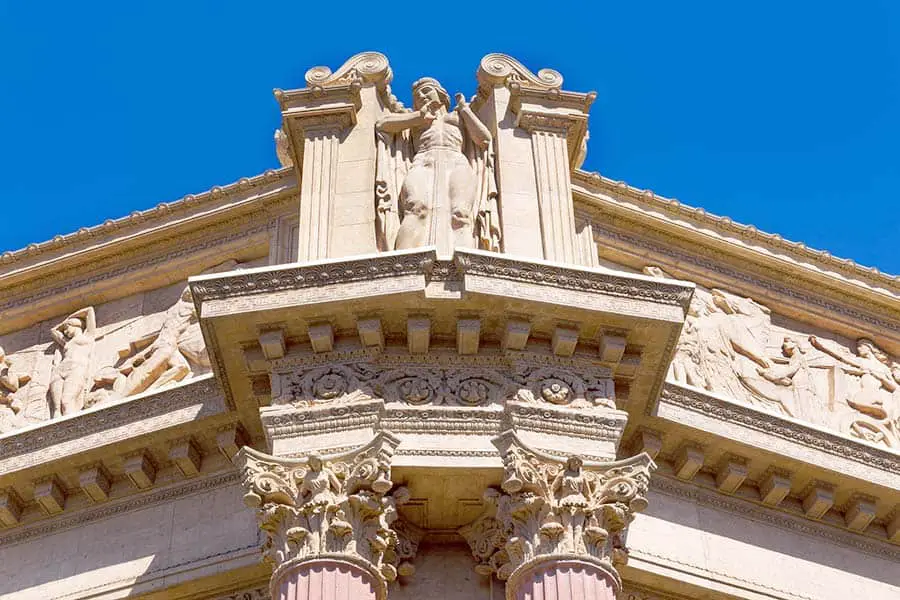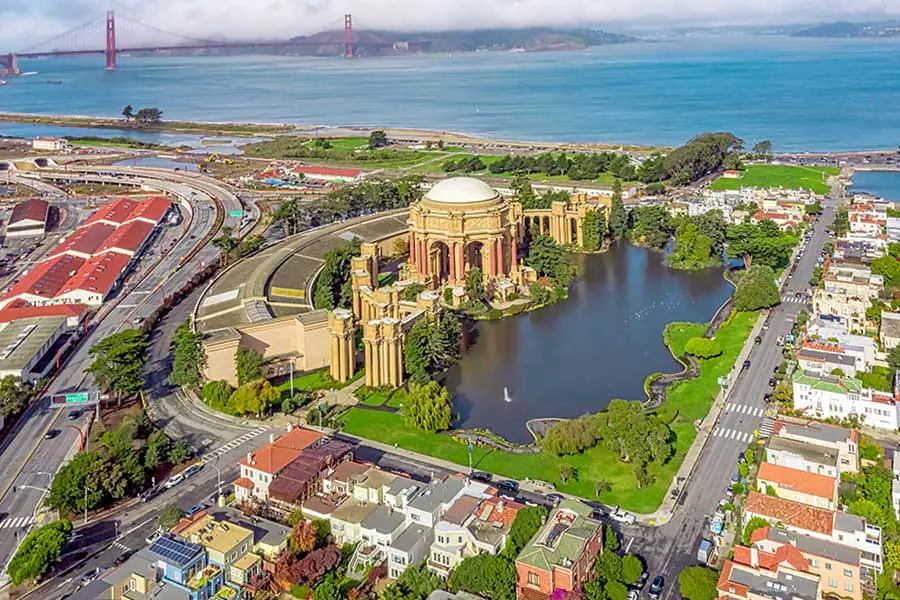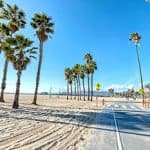
San Francisco is renowned for many things: its culture, its atmosphere, great food, Karl the Fog, and more. One place that may pique the curiosity of the resident of or visitors to this metropolis is the Palace of Fine Arts. Is it a palace? A hall for performing arts? What exactly is the Palace of Fine Arts?
The Palace of Fine Arts is a large and ornate building in San Francisco’s Marina District that was originally erected for the 1915 Panama-Pacific Exhibition. After extensive renovation and a complete rebuild of the original structure, the Palace is now a public monument for visitors to enjoy.
While it may not get the fame of neighboring landmarks such as the Golden Gate Bridge, The Palace of Fine Arts is deserving of recognition in its own right. Not only is it a beautifully executed reminiscence of the triumphal building styles of old, but the supporting vista also adds an element of natural beauty to this site and the history of this location helps us reflect on the advancement of mankind over the ages. Read on to learn more about this fabulous landmark.
The Palace of Fine Arts: An Echo from Yesteryear
In 1915, San Francisco was in need of some celebration. Recent earthquakes had been quite disruptive to the region, requiring extensive rebuilding. The development of World War I was gaining attention. In a world marked by struggle, the city needed to find something to enjoy. The completion of the Panama Canal provided a perfect excuse to host an exhibition.
The Panama-Pacific International Exhibition celebrated the achievements of the age. The sprawling fair covered more than 600 acres and featured exhibits of humanity’s technological prowess, such as telegraphy and automobiles. Technologies of different stripes were featured in correspondingly named Palaces; the Palace of Fine Arts was among them, dedicated to displaying the artistic achievements of humanity and creating a quiet space among the bustling expo.
Perhaps the most salient feature of the Palace of Fine Arts is the rotunda. One hundred sixty-two feet high and built in a style inspired by the ruins of Rome, the rotunda features a vast open space looking out onto a lagoon.

Architect Bernard Maybeck was tasked with creating a space that invited feelings of tranquility and quiet while visitors traversed the grounds on their way to other Palaces. And he landed on the idea of Ancient Greek and Roman ruins: what better way to celebrate the achievements of mankind than to reflect on the great civilizations of old?
The Palace of Fine Arts was just one of many landmark Palaces that were constructed during the Panama-Pacific Exhibition. Neighboring Palaces included the Palaces of Manufacture, Liberal Arts, Transportation, and Mines and Metallurgy. While the neighboring Palaces were demolished after the exhibition’s completion, the Palace of Fine Arts appealed to the public in a different way, and it was spared.
After the exhibition ended and it was decided to spare the Palace from the wrecking ball’s wrath, the building supported a variety of uses. For some time, the Palace served as a place where visual arts were on display, but as time went on, it was converted to tennis courts. During WWII, the Army commandeered the Palace and used it as a motor pool. Post-war, the City of San Francisco found other miscellaneous uses for the building until it eventually became a liability – it was built to display, not to endure.
In 1964 the Palace was demolished, but only to make way for a vastly improved structure. In 1974 reconstruction was completed, bringing the Palace into modernity with the use of proper construction techniques and more current and appropriate materials. In 2009, the Palace was retrofitted and improved to withstand seismic events, ensuring its presence into the future. Today, the Palace remains an iconic structure in San Francisco, a delightful anachronism in the modern urban landscape.
Other Posts of Interest
- What Are The Painted Ladies In San Francisco?
- Does San Francisco Have Seals Or Sea Lions?
- Why Is San Francisco So Foggy?
- Can You Walk Down Lombard Street In San Francisco?
Bay Area Answers Fun Fact: While most of the buildings at the Panama-Pacific Exhibition were demolished at the conclusion of the event, the Palace was so beloved by locals that a campaign – funded by Phoebe Apperson Hearst of the famed Hearst family – rallied to conserve and keep the Palace as part of San Francisco.
How Long Did it Take to Build the Palace of Fine Arts?
The original structure of the Palace of Fine Arts was constructed in a short period shortly before the 1915 exhibition. The Palace was intended to be a short-lived building. It was not built with proper techniques and materials; by the time the Palace met the bulldozer in 1964, it had transitioned from a fake ruin to an actual ruin.
Construction of the more durable Palace took approximately ten years from start to finish. Builders used modern materials and techniques to ensure the Palace was built correctly and would endure through the ages. The final step was the capping of the rotunda, which took place in 1974.
Is There Symbolism in the Architecture

Bernard Maybeck, the architect of the original palace, was tasked with creating a space that would offer visitors a sense of quiet and stillness. As a student of the Beaux-Arts style of architecture, which borrowed heavily from ancient influences, Maybeck jumped at the opportunity to design a modern Roman ruin. The carefully sculpted pond, the rotunda, and the slender, skybound colonnade evoked for visitors a sense of quiet sadness. The reflecting pond is a tribute to European architecture more broadly and echoes the tradition of having reflecting ponds near magnificent features.
Is There Art on Display at the Palace of Fine Arts?
Despite the name, the Palace of Fine Arts is not used as an art museum. You will not find any paintings or sculptures on display here. However, fans of the performing arts can journey to The Palace of Fine Arts Theater, which frequently hosts various performances and productions. These productions are not public events, so tickets will need to be purchased ahead of time – there is no box office at the theater.
Despite the lack of formal art exhibitions, there is some symbolic art contained within the Palace. The rotunda contains panels of Greek-style artworks by Bruno Zimm representing the “struggle for the beautiful.” A set of eight panels set into the dome depict the origins and birth of Art and California’s four golds – elemental gold, wheat, citrus, and poppies.
Who Owns the Palace of Fine Arts?
The Palace of Fine Arts is owned by the City of San Francisco and is open to the public. Nearby venues that are part of the Palace complex are privately owned, but the Palace itself and the surrounding parklands are publicly accessible.
Indeed, some may say that the Palace is one of the crown jewels in San Francisco’s park system. You can enjoy a fine California afternoon and take in the vista through the rotunda’s arches, walk along the water features, and look for the birds and creatures who live on the park grounds.
Can You Walk Around the Palace of Fine Arts?

Yes, you can walk around the Palace of Fine Arts, it is surrounded by public parkland, meaning that you can visit and stroll through the beautiful architecture and enjoy the local wildlife. Fountains and other water features provide pleasant visual anchors. Many varieties of waterfowl and seabirds inhabit the pond, along with turtles, fish, and other small creatures.
The adjacent venue, known as the Venue at the Palace of Fine Arts, is a privately-owned event space that hosts corporate events, weddings, and other gatherings of people. This venue is private and is not part of the publicly accessible park.
What is The Palace of Fine Arts Used for Now?
The Palace of Fine Arts originated in a festival celebrating the achievements of mankind, and in a strange way, it continues this tradition. While it has a storied history and has been used as everything from a tennis court to a motor pool, it currently exists to provide the denizens of and visitors to San Francisco with a place to enjoy fine architecture and relax outdoors. Many people enjoy hosting weddings or other events at the Palace, owing to the splendid architecture and the surrounding vistas.
A Palace for the Public
The Palace of Fine Arts was intended to be a quiet place for reflection and rumination, a land apart from the bustle and buzz of the other Palaces highlighting industry and science. Indeed, while one of humanity’s defining characteristics is a ceaseless drive to invent and create tools and technologies, another is the very human need for creative expression through visual arts, song, dance, and spoken words.
Modern San Francisco is considered a hub for the technologies and sciences of our age, but it is also a place of striking visual beauty and a home to the arts. The Palace of Fine Arts serves as a reminder that even in an age of technology, we can stop to enjoy the artistic creations as well as the technological feats of human beings. Now, as then, the Palace of Fine Arts helps us remember a different side of the human experience.





